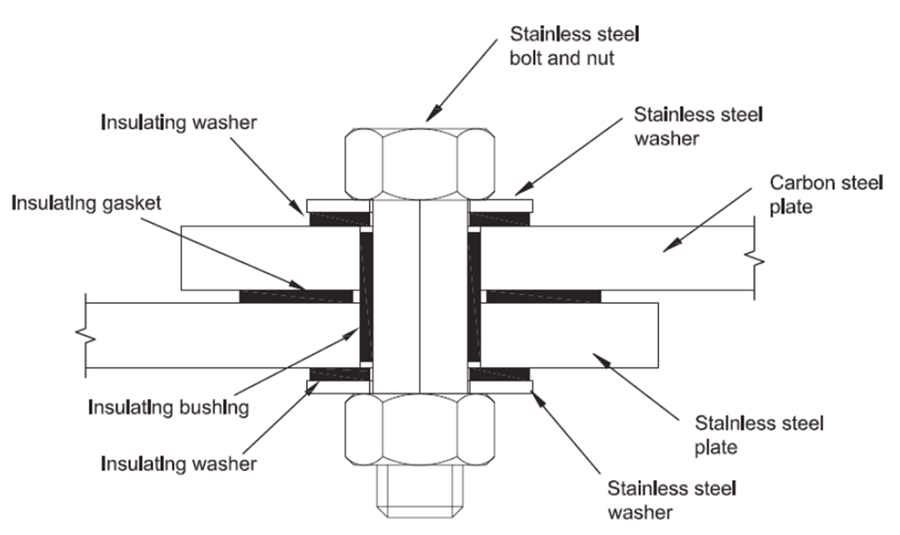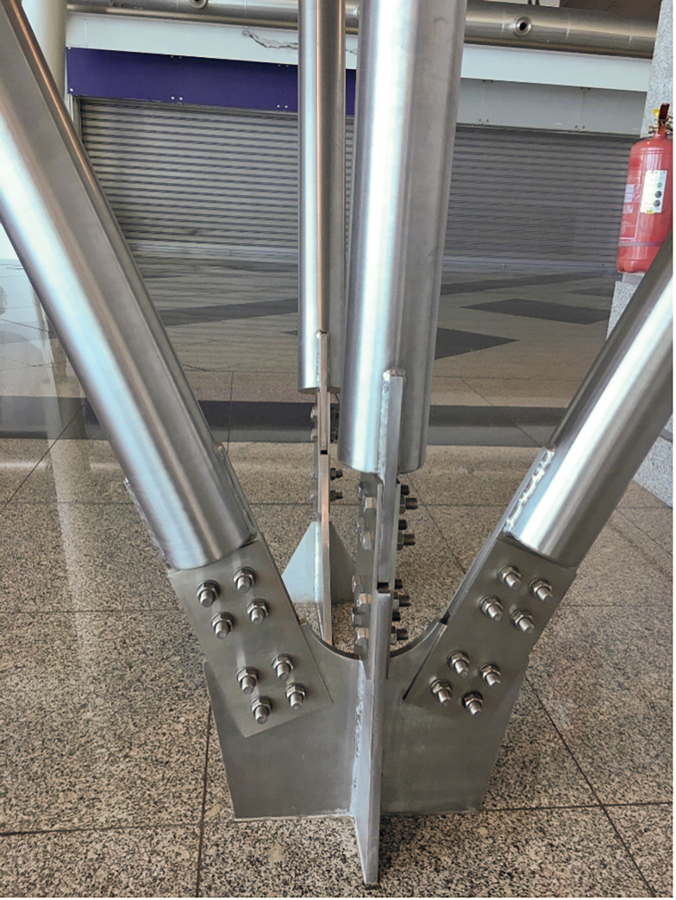Design rules for bearing-type and slip-critical bolted connections made of stainless steel are now available.
In the December 2022 edition of Structure Magazine, Benjamin Baer gave an overview of the new AISC design specification for structural stainless steel, ANSI/AISC 370, and introduced the provisions for designing members. This article focuses on the design of bolted connections in structural stainless steel.

Introduction
Stainless steel bolts are used in a wide range of architectural and industrial applications (such as water treatment, food processing, chemical processing, marine structures, and nuclear facilities) where carbon steel bolts would be simply inadequate. They are available in various alloys and conditions, offering different strengths, corrosion resistance levels and the ability to operate at high and low temperatures. Even though stainless steel bolts have a higher initial cost than their carbon steel equivalents, the savings from a long life with low maintenance can easily outweigh these initial costs in demanding applications. As well as being essential for connecting stainless steel members, stainless steel bolts are also suitable for connecting galvanized steel and aluminum members. They are also used in timber construction because they are resistant to chemicals used to treat timber, and also resistant to corrosion caused by acetic acid which is emitted by timber.
Design of Bolted Connections
The design of stainless steel bolted connections in the US has become significantly easier thanks to the release in 2021 of the Specification for Structural Stainless Steel Buildings (ANSI/AISC 370) and its accompanying Code of Standard Practice for Structural Stainless Steel Buildings (AISC 313). The second edition of Design Guide 27 Structural Stainless Steel (AISC DG 27), released in 2022, also gives practical guidelines for designing stainless steel bolted connections and provides design tables for determining their strength.
Stainless steels can be classified into five basic groups, with each group providing unique properties and a range of different corrosion levels. ANSI/AISC 370 covers the design of members and bolts made from the austenitic and duplex stainless steel alloy groups, which are the most commonly used structural stainless steels. The design of precipitation hardening stainless steel alloys is also covered for tension members, fittings and fasteners where higher strength is needed.
A summary of the design rules and key recommendations for bolted connections is given below.
Material Selection and Specification
An important consideration when selecting a stainless steel bolt, nut, and washer is to ensure they have a corrosion resistance at least as good as that of the most corrosion-resistant material being joined. When a structure is exposed to a corrosive environment, the connections are the parts most affected by the aggressive environment as they are susceptible to crevice corrosion, stress corrosion cracking, and galvanic corrosion if dissimilar metals are connected.
The potential for crevice corrosion at a connection should be considered in any environment where moisture is present and surface deposits may accumulate, particularly those containing chloride salts. Crevice corrosion can occur at locations that are shielded or occluded and have insufficient localized oxygen concentrations that are too low to maintain a passive film. Possible sources of moisture include spray, ponding, rain, fog, condensation, and humidity. When crevice corrosion is a concern, the most common design options are to seal the joint, modify the design to reduce the risk of regular moisture accumulation or select a stainless steel alloy with sufficient crevice corrosion resistance for the service environment.


The development of chloride stress corrosion cracking (SCC) requires the simultaneous presence of tensile stresses and a chloride-rich environment, which is unlikely to be encountered in standard building atmospheres. Service environments potentially prone to chloride SCC include indoor swimming pool areas, specific industrial and food processing environments, and structural members in areas with high coastal or de-icing salts accumulation. The stresses do not need to be very high in relation to the material’s yield stress. They may be due to loading or residual effects from manufacturing processes. Caution should be exercised when stainless steel members containing high residual stresses (e.g., due to cold working) are used in chloride-rich environments. Duplex stainless steel bolts usually have superior resistance to SCC than the austenitic stainless steel bolts covered in ANSI/AISC 370. Precipitation hardening stainless steel bolts should not be used when SCC is a concern. The potential for galvanic corrosion should also be considered in bolted connections that combine stainless steel with other metals. In this type of connection, the dissimilar metals must be isolated from one another electrically. This usually includes using insulating washers and bushings to prevent contact between the bolt and members being joined so that galvanic corrosion is avoided if there is moisture infiltration or condensation within the joint. Figure 1 shows an example of galvanic separation of dissimilar metals for a bearing-type connection, in which the bolt is snug-tightened, in a water-shedding application. The connection in Figure 1 would not be an appropriate design for a regularly or continuously immersed condition or where crevice corrosion of the stainless steel was a concern. Because of the need for isolating material, slip critical connections cannot be used for joining dissimilar metals.
Several ASTM standards cover stainless steel bolts. Most stainless steel bolt standards have a corresponding standard for the nut unless the nut is specified in the same standard as the bolt (this is the case for ASTM A1082/A1082M, which covers stainless steels suitable for bolts and nuts).
The ASTM standards covering stainless steel bolts are given in Table 1. There are no ASTM standards for stainless steel washers. However, requirements are given in ANSI/AISC 370 regarding material selection and hardness.
For the austenitic stainless steel bolts, although all the standards give the same values for yield strength and tensile strength of bolts in the annealed condition (Fyb = 30ksi, Fub = 75 ksi), the strengths in the cold worked condition and strain-hardened condition depend on both the alloy and the diameter of the bolt. Strength and size are inversely correlated because it is difficult to achieve uniform work hardening through the thickness of a bolt. For the duplex stainless steel bolts, the yield and tensile strengths vary between alloys, and in the case of precipitation hardening stainless steel bolts, they also vary with the heat treatment. (ANSI/AISC 370 permits the precipitation hardening alloys only in heat treatment condition H1150 to reduce the risk of hydrogen embrittlement and SCC).

Structural Performance of Stainless Steel Bolted Connections
Stainless steel bolts behave differently from carbon steel bolts due to the different material composition and non-linear stress-strain characteristics. This means it is only possible to adopt some of the design rules and installation procedures used for carbon steel bolts.
Bearing-type Connections
As with carbon steel, the strength of stainless steel bearing-type connections may be governed by the failure of the bolt itself or the connected plates. Failure of the bolt may be due to shear, tension, or a combination thereof, while the connected plates may fail in bearing or tearing when the spacing between bolts or the spacing between the bolt and the edges of the plate is not sufficient. The minimum bolt spacing and edge distance requirements are the same for stainless steel and carbon steel bolted connections.
The strength provisions given in ANSI/AISC 370 for stainless steel bolts are similar to those for a carbon steel bolt of the same diameter and tensile strength (Fub). As for carbon steel bolts, the shear and tensile strengths of a stainless steel bolts are calculated by multiplying the nominal (tensile or shear) stress by the nominal unthreaded area of the bolt. If the bolt is subjected to combined tension and shear, the strength is predicted using the same interaction equation used for carbon steel bolts. However, due to the wide variety of stainless steel bolts on the market, each with different tensile strength (Fub), rather than tabulating the nominal (tensile and shear) stresses, ANSI/AISC 370 provides simple expressions for calculating these values.
For stainless steel bolts in tension, the nominal tensile stress is given by 0.75Fub, where the 0.75 coefficient accounts for the reduced cross-sectional area of the threaded part of the bolt. Similarly, if shear failure occurs in the threaded portion of the bolt, the nominal shear stress of the unthreaded portion of the bolt (0.55Fub) is reduced to 0.45Fub to compensate for the reduced cross-sectional area of the threaded part of the bolt. The 0.55 and 0.45 coefficients include a 10% reduction in strength to account for the detrimental effect of the uneven redistribution of stresses in long-bolted connections.
The resistance factor used in calculating the available strength of austenitic and duplex stainless steel bolts is the same as that used for carbon steel bolts. However, it was reduced by 10% for precipitation hardening stainless steel bolts to account for the lack of sufficient test data on this type of bolt.

The equations for calculating the bearing and tearing strength of stainless steel plates have a similar form to those used for carbon steel plates, with the tearing strength increasing proportionally to the bolt-to-bolt or bolt-to-edge distance until the bearing strength is reached. However, stainless steel plates will exhibit lower bearing and tear-out strengths due to the gradual softening of the material. As for carbon steel bearing-type connections, the bearing/tear-out strength of the plate can be determined for the case in which the deformation at the bolt hole under service loads is or is not a design consideration.
Slip-critical Connections
Slip-critical connections are required when deformations in bolted connections must be limited to predefined values under service or ultimate loads. Typical applications can be found in bridges, cranes, radio masts, and towers of wind turbines. In this type of connection, the shear force is transferred by friction between the faying surfaces, and therefore, ensuring that the level of pretension in the bolt and the slip coefficient of the faying surfaces are achieved is key to guaranteeing the strength of the connection.
ANSI/AISC 370 covers the design of slip-critical connections in which the bolt is made of austenitic or duplex stainless steel with a specified minimum yield strength Fyb ranging from 80 ksi (550 MPa) to 130 ksi (900 MPa) and faying surfaces made of stainless steel plates. The reader should be aware that there is a typographical error in the upper bound limit of Fyb (<= 116 ksi (800 MPa)) given in the current version of ANSI/AISC 370, which will be corrected in the next edition in 2025. The use of slip-critical connections comprising stainless steel bolts and carbon steel plates is outside the scope of ANSI/AISC 370. This is because in this type of connection, the dissimilar metals would need to be isolated similarly to the connection shown in Figure 1 with the washers and bushings made of an incompressible material, for which there is currently no data.
To limit the surface pressures on the clamped package and thus minimize pretension losses due to plastification of the surface, ANSI/AISC 370 requires washers hardened to at least 290 Brinell HBW to be placed under both the bolt head and the nut. Embedding of the surface can also be minimized using washers with a diameter larger than the nut or the head of the bolt.
Galling can occur when the bolt is highly pre-tensioned or torqued, and stainless steel bolting assemblies are more susceptible to this than carbon steel bolting assemblies. Therefore, the use of lubrication during the installation of slip-critical bolting assemblies is essential to minimize galling. It is recommended that the lubricant is applied between the paired threads and the bearing surfaces between the nut and the washer.

The nominal strength of stainless steel slip-critical connections is calculated by the same equation used for carbon steel slip-critical connections, which is given by Equation 1, where: Du is a multiplier that reflects the ratio of the mean installed bolt pretension to the specified minimum bolt pretension; Tb is the specified minimum bolt pretension, hf is a reduction factor that is used when two or more fillers are placed between the connected parts (hf is the same as for carbon steel slip-critical connections); ns is the number of slip planes, and μ is the slip coefficient for the faying surfaces.

The resistance factors used to calculate the available slip resistance for different hole types (i.e., standard size, slotted and oversized holes) are also the same as those used with carbon steel slip-critical connections.
An important distinction when calculating the resistance of stainless steel slip-critical connections is that the minimum bolt pretension Tb is taken as 70% of the yield strength of the bolt multiplied by the net tensile area of the bolt. This definition of Tb differs from that for carbon steel slip-critical connections, which is based on 70% of the tensile strength of the bolt. The reason Tb is based on the yield strength of the bolt is that tests on stainless steel bolts have shown that it is only sometimes possible to guarantee a minimum bolt pretension as high as 70% of the tensile strength.
To ensure that the specified minimum bolt pretension is achieved, ANSI/AISC 370 requires that the stainless steel bolting assembly, as well as its installation process, meet the requirements of a Bolt Tightening Qualification Procedure, such as the one included in AISC DG 27, which covers the turn-of-nut, the calibrated wrench, and the combined methods.
The value of the multiplier Du in Equation (1) was conservatively set to 1.0 for stainless steel slip-critical connections because there was insufficient data to justify a higher value. This contrasts with the value of 1.13 used for carbon steel slip-critical connections, for which significantly more data is available on the different bolt installation methods.
In stainless steel slip-critical connections, the slip coefficient μ is primarily dependent on the roughness and asperity of the faying surfaces, the latter being controlled by the type of media used to blast the surfaces. Table 2 shows the current slip coefficient values given in ANSI/AISC 370. These values are only applicable to grit-blasted faying surfaces that meet the defined roughness values given in Table 3. If a faying surface with different surface roughness is used, tests can be conducted according to the testing method given in AISC DG 27 to determine the appropriate slip coefficient to use in
the design.
When a slip-critical connection is subject to both tension and shear, the tensile force reduces the clamping force between the faying surfaces, reducing the slip resistance of the connection. This effect is accounted for by applying the same reduction factor used for slip-critical connections made of
carbon steel.
Summary
Stainless steel bolts have a long track record of providing durable solutions for connecting a wide range of materials. The design process is similar to that of carbon steel bolts. Care is needed in specifying stainless steel bolts as there are a range of alloys and conditions (strengths). Guidance is available in ANSI/AISC 370 and AISC DG 27. In the coming months, an RCSC/AISC stainless steel bolting guide will be prepared, with essential information for specifiers and designers all in one place.■
